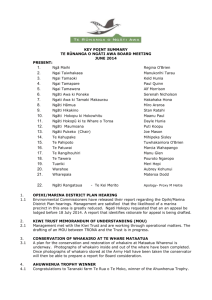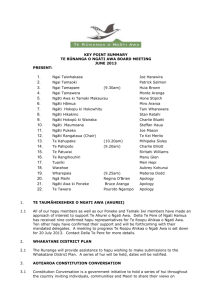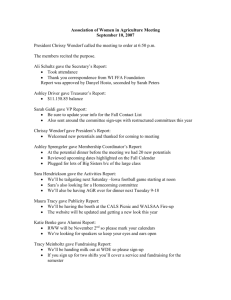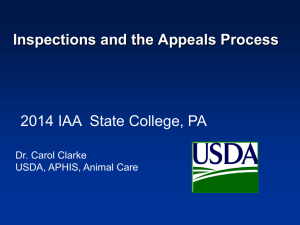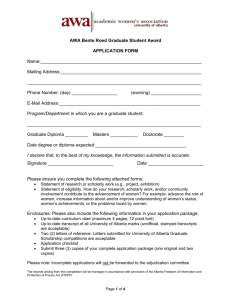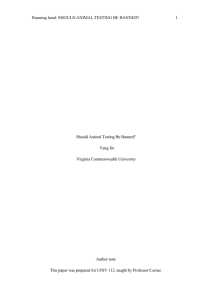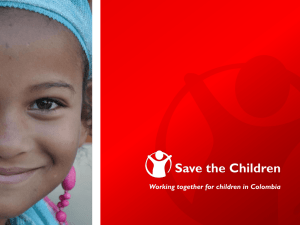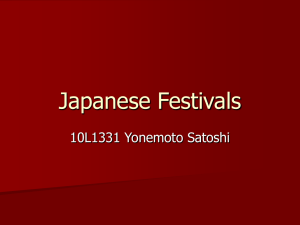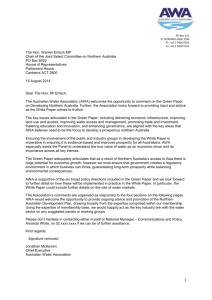54599921_Hearing statement Ray Thompson_(v1)
advertisement
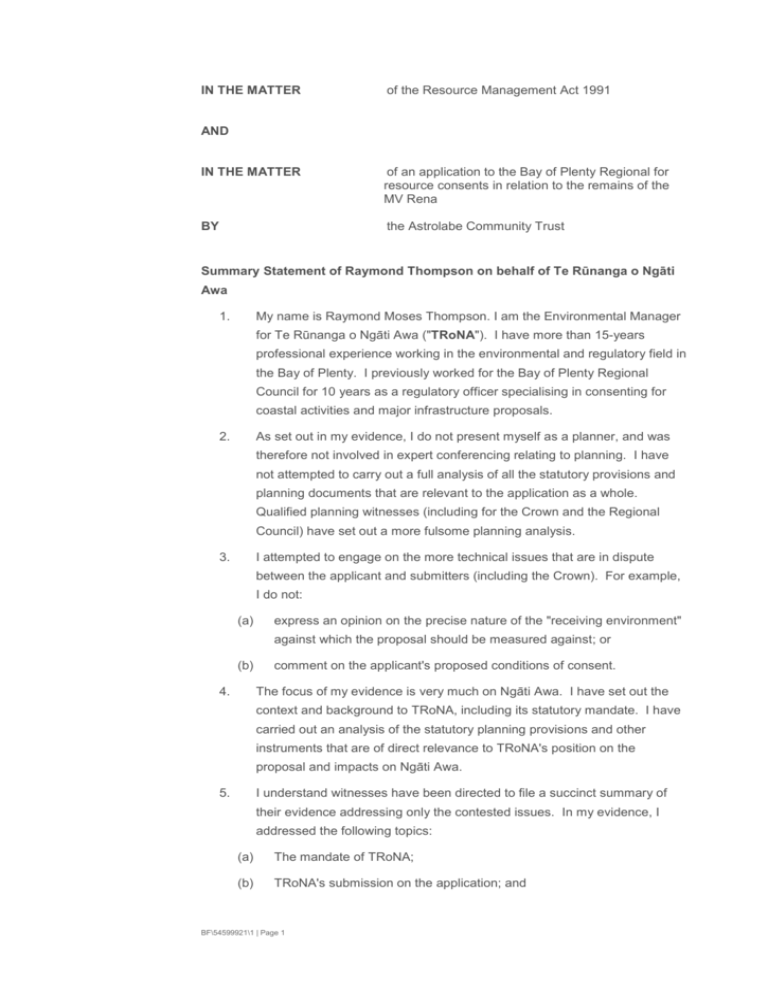
IN THE MATTER of the Resource Management Act 1991 AND IN THE MATTER of an application to the Bay of Plenty Regional for resource consents in relation to the remains of the MV Rena BY the Astrolabe Community Trust Summary Statement of Raymond Thompson on behalf of Te Rūnanga o Ngāti Awa 1. My name is Raymond Moses Thompson. I am the Environmental Manager for Te Rūnanga o Ngāti Awa ("TRoNA"). I have more than 15-years professional experience working in the environmental and regulatory field in the Bay of Plenty. I previously worked for the Bay of Plenty Regional Council for 10 years as a regulatory officer specialising in consenting for coastal activities and major infrastructure proposals. 2. As set out in my evidence, I do not present myself as a planner, and was therefore not involved in expert conferencing relating to planning. I have not attempted to carry out a full analysis of all the statutory provisions and planning documents that are relevant to the application as a whole. Qualified planning witnesses (including for the Crown and the Regional Council) have set out a more fulsome planning analysis. 3. I attempted to engage on the more technical issues that are in dispute between the applicant and submitters (including the Crown). For example, I do not: (a) express an opinion on the precise nature of the "receiving environment" against which the proposal should be measured against; or (b) comment on the applicant's proposed conditions of consent. The focus of my evidence is very much on Ngāti Awa. I have set out the 4. context and background to TRoNA, including its statutory mandate. I have carried out an analysis of the statutory planning provisions and other instruments that are of direct relevance to TRoNA's position on the proposal and impacts on Ngāti Awa. 5. I understand witnesses have been directed to file a succinct summary of their evidence addressing only the contested issues. In my evidence, I addressed the following topics: (a) The mandate of TRoNA; (b) TRoNA's submission on the application; and BF\54599921\1 | Page 1 (c) Comment on relevant statutory provisions and planning instruments (as they relate directly to Ngati Awa). 6. In this statement I summarise my evidence on these topics. In doing so, and in an attempt to assist the hearing panel, I have focussed on those points that have not been addressed in detail in the evidence presented for applicant and other submitters and where there is contention. 7. On a preliminary matter I respond to statements made by Ms Bennett 1and Mr Pou2, witness and counsel for Te Arawa. The Hearing has heard statements by those witnesses that Ngati Awa has been inconsistent with regard to their consideration of effects on mauri making reference to the sinking of the Seafire as a dive attraction off Moutohora in 2008. Ms Bennett and Mr Pou contend that Ngati Awa’s approval for the sinking of the Seafire represents a change in Ngati Awa’s view on the impacts of a ship or structure on the mauri of taonga. The witnesses go so far as to infer that this brings into question the validity of Ngati Awa’s current opposition to the wreck of the Rena remaining on Otaiti. 8. As you are likely aware I was the Regional Council processing officer for the Seafire consent process and author of the Officers report referred to by the witnesses. The comparison by the witnesses between the Seafire and the proposal to leave the remains of the Rena on Otaiti are both inappropriate and misleading to the Hearings panel. The Seafire was purposely prepared as an artificial dive attraction being “appropriately decommissioned and cleansed prior to final deployment”. While the coastal waters in general surrounding Moutohora are indeed culturally significant the proposal and sites were developed through extensive consultation with Ngati Awa representatives to avoid known areas of specific cultural significance. 9. This is clearly in contrast to the Rena proposal where the vessel was not appropriately decommissioned and prepared for sinking and there has been no ability to consider site selection. Of more critical importance, Ngati Awa have established that the reef Otaiti is a taonga, waahi tapu and pataka kai of cultural and spiritual significance. The site selection process for the scuttling of the Seafire fully involved Ngati Awa resulting in the vessel being positioned over a flat sand/mud bottom specifically avoiding areas or cultural value. Therefore it is my opinion that there is no useful comparison between the Seafire and Rena situations and that there is no justification for any inference that Ngati Awa’s consideration of cultural values has been inconsistent. 1 2 Hearing Statement for Piatarihi Bennett for Te Arawa, dated 10th September 2015, at paragraphs 20 - 22 Submission for Jason Pou for Te Arawa, dated 10th September 2015, at paragraph 53 BF\54599921\1 | Page 2 Te Rūnanga o Ngāti Awa Mandate TRoNA is constituted under the Te Rūnanga o Ngāti Awa Act 2005 ("the 10. Runanga Act") and is subject to the Charter of Te Rūnanga o Ngāti Awa. Section 6 of the Runanga Act confirms that TRoNA is to act as the representative body for Ngāti Awa. This reflects the mandate given by the people of Ngāti Awa to TRoNA. TRoNA is recognised as the governance entity for Ngāti Awa and its hapū 11. under the Ngāti Awa Deed of Settlement and Ngāti Awa Claims Settlement Act 2015 ("the Settlement Act"). The Deed of Settlement and Settlement Act: (a) Settle the historical claims of Ngati Awa, including in respect of Motiti Island; (b) State that Te Patuwai and Ngati Maumoana (the principal hapu of Motiti Island) are hapu of Ngati Awa; (c) Confirm that Motiti Island is within Ngati Awa's "area of interest" in respect of its historical claims under the Treaty of Waitangi. 12. In his hearing statement Sir Wira Gardiner (witness for the applicant) confirms TRoNA’s mandate and states Te Patuwai holds mana whenua for Motiti3. 13. As of July 2015 there are 19,899 registered descendants of Ngāti Awa. Ngāti Awa descendants from Te Patuwai and Ngati Maumoana hapu are tangata whenua, kaitiaki, and landowners at Motiti. 14. Te Runanga o Ngati Awa is in my view the appropriate entity to speak for Ngati Awa and its people in respect of this resource consent application. Relevant Statutory Instruments and Planning Provisions: Documents included in the Common Bundle 15. In my evidence I discussed the key statutory and planning provisions that are of direct relevance to Ngati Awa's case. Most of these were also discussed in detail by witnesses for the applicant and other submitters and are included in the common bundle of statutory instruments. 16. I set out below a brief summary of my views on those instruments included in the common bundle. Treaty of Waitangi 3 Hearing Statement for Harawira Gardiner for the Applicant, dated 10th September 2015, paragraph 10 BF\54599921\1 | Page 3 17. The actions of the Government in failing to more actively seek the removal of the MV Rena amount to a breach of the principles of the Treaty of Waitangi. 18. Granting consent for the wreck of the Rena to remain on Otaiti would be a breach of the principles of Te Tiriti by the Crown. Part 2 of the RMA 19. The proposal to abandon the remains of the Rena is contrary to the sustainable management purposes of the Resource Management Act 1991 ("RMA") as set out in section 5 of the RMA. Granting consent would not provide for the social, economic and cultural wellbeing of tangata whenua and would fail to protect and sustain the potential of natural resources to meet the reasonably foreseeable needs of future generations; 20. Mr Ngaropo has explained that Otaiti is a waahi tapu, taonga and pataka kai of considerable physical and spiritual significance to Ngati Awa; and that the mauri of Otaiti has been severed by the wreck of the Rena and can only be restored once all practical efforts to remove the wreck have been undertaken. Ms Ratahi-Pryor has explained that the cultural relationship between Ngati Awa and Otaiti also creates a significant relationship in terms of the mental and physical health and well-being of the people. 21. On this basis, the granting of consent would not recognise and provide for "the relationship of Ngati Awa and their culture and traditions with their ancestral lands, water, sites, waahi tapu and other taonga" as a matter of national importance under section 6(e) of the RMA. 22. In my opinion the proposal would fail to preserve and protect the outstanding natural character and landscapes of Otaiti and surrounding cultural waters which are a matter of national importance under s6(a) and 6(b) of the RMA. 23. Otaiti and its surrounding waters are arguably an area of significant indigenous vegetation and habitat of indigenous fauna under s6(c) of the RMA. I consider the proposal fails to protect this significant area and habitat. 24. The proposal is contrary to a number of the listed "other matters" that the panel must have particular regard to under section 7 of the RMA. In particular, allowing the wreck to remain in place is contrary to the principle of kaitiakitanga (s7(a)). 25. The hearing panel must take into account the principles of the Treaty of Waitangi under section 8 of the RMA. In my view, granting the application would be contrary to the principles of the Treaty of Waitangi. BF\54599921\1 | Page 4 New Zealand Coastal Policy Statement 26. The New Zealand Coastal Policy Statement ("NZCPS") includes a number of objectives and policies of direct relevance to Ngāti Awa's position and role as tangata whenua and kaitiaki of Otaiti. The key objectives and policies I have identified as being relevant are: objective 2 and policy 13; objectives 6 and 3 and policy 2; and policies 3, 11, 15 and 17. 27. Objective 2 aims to "preserve and protect the natural character of the coastal environment". Policy 13 gives effect to this objective, particularly 13(1)(a), which directs that adverse effects are to be avoided in areas of outstanding natural character. The ongoing presence of the remains of the Rena will continue to degrade outstanding natural character values of Otaiti, making the proposal inconsistent with objective 2 and policy 13(1)(a). 28. Expert witnesses including Rebecca Ryder for the Regional Council, have concluded that while there may be significant adverse effects on natural character in that part of the reef where the remains of the Rena rest, that overall the reef retains its outstanding natural character status.4 Unfortunately and maybe inadvertently this appears to imply that there is justification for leaving the wreck on the reef without adversely affecting its assessed outstanding natural character. This is relevant given the direction to avoid, rather than remedy or mitigate adverse effects under Policy 13 of the NZCPS. 29. It is my opinion that this conclusion is flawed and would introduce a “ceiling” approach to dealing with adverse effects within areas of outstanding natural character where decision makers would not be compelled to require appropriate actions to further preserve and protect natural character. 30. I note that Appendix J of the RPS identifies the remains of the MV Rena as an attribute that diminishes natural character at the site. I also note that in a previous process representatives for the owners of the MV Rena sought to have the outstanding natural character status of Otaiti downgraded by way of submission to the RPS and subsequent Environment Court action. It is assumed that this was an attempt to deal with the “avoidance” direction of Policy 13 of the NZCPS with regard to their desire to abandon the remains of the Rena on Otaiti. 31. The proposal is also contrary to objective 6 of the NZCPS, which aims to "enable people and communities to provide for their social, economic, and cultural wellbeing…” 44 Summary of Evidence of Rebecca Ryder for BOPRC, dated 14 September 2015, paragraph 8 BF\54599921\1 | Page 5 32. Ngāti Awa's physical and spiritual connections with Otaiti have been adversely affected by the presence of the wreck of the Rena. If the wreck remains, these adverse effects will continue, and this objective will not be upheld. 33. Policy 3 of the NZCPS requires consent authorities to adopt a precautionary approach towards proposed activities whose effects are uncertain, unknown, or little understood but are potentially significantly adverse. 34. I am concerned that the potential for future releases of harmful contaminants from the remains of the Rena, specifically the estimated 16 tonnes of cooper clove poses a significant risk to Otaiti and the surrounding environment. In adopting a precautionary approach, the consent application should be refused. Bay of Plenty Regional Policy Statement 35. The RPS provides a framework for promoting sustainable management in the Bay of Plenty including issues of significance to Ngāti Awa. Appendix J (tables) and Appendix I (maps) of the RPS is particularly important as it classifies the natural character of Otaiti as "Outstanding". 36. I have also noted in my evidence that the following policies are particularly relevant to Ngāti Awa: CE 2B; MN 7B; IW 2B; IW 5B; and IW 6B. 37. In my view, the hearing panel should carefully consider these policies in the context of the application. 38. Policy CE 2B aims to: "Avoid adverse effects of activities on the attributes that comprise natural character in areas of the coastal environment with outstanding natural character as identified in the maps and tables in Appendix I and J." 39. The presence of the remains of the Rena adversely affects and continues to degrade the natural character of Otaiti. 40. Policy MN 7B provides guidance for assessing 'appropriateness' in areas that warrant protection under section 6 RMA. It requires particular consideration to be given to "Outstanding natural features and landscapes" and "Māori culture and traditions." BF\54599921\1 | Page 6 41. Policies IW 2B and IW 5B are particularly important to Ngāti Awa regarding matters of significance to Māori. Policy IW 2B states that proposals must "recognise that only tangata whenua can identify and evidentially substantiate their relationship and that of their culture and traditions with their ancestral lands, water, sites, waahi tapu and other taonga." 42. Policy IW 5B lists the effect on the exercise of kaitiakitanga, mauri, and mahinga kai as necessary considerations for proposals that may adversely affect any matter of significance to Māori. 43. In his evidence Mr Ngaropo demonstrates that Ngāti Awa's kaitiakitanga and ability to use the natural resources of Otaiti as a mahinga kai, as well as the mauri of the reef, have been adversely affected by the grounding of the Rena, and will continue to be affected should the wreck remain. 44. Policy IW 6B encourages tangata whenua to identify measures to avoid, remedy, or mitigate adverse cultural effects. TRoNA has stated that the only measure considered appropriate to avoid and begin to remedy the adverse effects on Ngāti Awa's cultural values is for the remains of the MV Rena and all associated cargo, debris and contaminants to be removed from Otaiti and the surrounding coastal waters. Bay of Plenty Coastal Environment Plan 45. The stated purpose of the Bay of Plenty Coastal Environment Plan ("RCEP") is to promote the sustainable management of the Bay of Plenty Coastal Environment as defined in section 5 of the RMA. 46. Part II of the RCEP addresses matters of national importance listed in section 6 of the RMA and how persons exercising functions and powers under the RMA shall recognise and provide for those matters of national importance in relation to managing the use, development and protection of natural and physical resources. 47. The objectives and policies under Part II, section 8 aim to involve tangata whenua in management of the coastal environment, protect the characteristics of the coastal environment of significance to tangata whenua and sustain the mauri of coastal resources. 48. Methods 8.2.4(a) – (k) state that Environment Bay of Plenty and the iwi of the region will do a number of things to achieve these objectives and policies, including develop methods to protect the mauri of the natural and physical resources of the coastal marine area, and protect sites with cultural value or special significance to tangata whenua. 49. The continued presence of the remains of the Rena is in my view contrary to these provisions of the RCEP. The only way to remedy this situation is BF\54599921\1 | Page 7 for the remains of the MV Rena and all associated debris and contaminants to be removed from Otaiti. Other relevant documents not included in the Common Bundle 50. My evidence addresses three other documents not included in the common bundle, but which I consider relevant "other matters" to be considered by the hearing panel under section 104(1)(c) of the RMA: (a) the United Nations Declaration on the Rights Of Indigenous Peoples; (b) the Mataatua Declaration on Cultural & Intellectual Property Rights of Indigenous Peoples; and (c) the Mataatua Declaration on Water. United Nations Declaration on the Rights of Indigenous Peoples 51. The United Nations Declaration on the Rights of Indigenous Peoples ("UNDRIP") was adopted by the United Nations General Assembly on 13 September 2007. The UN General Assembly recognised: "…the urgent need to respect and promote the inherent rights of indigenous peoples which derive from their political, economic and social structures and from their cultures, spiritual traditions, histories and philosophies, especially their rights to their lands, territories and resources…" 52. UNDRIP was proclaimed by the UN General Assembly to be an agreed standard for all member nations around the world (including New Zealand) regarding the recognition and protection of cultural knowledge and indigenous property rights. Article 11 and 31 of UNDRIP state: "Indigenous peoples have the right to practice and revitalise their cultural traditions and customs. This includes the right to maintain, protect and develop the past, present and future manifestations of their cultures, such as archaeological and historical sites, artefacts, designs, ceremonies, technologies and visual and performing arts and literature." "Indigenous peoples have the right to maintain, control, protect and develop their cultural heritage, traditional knowledge and traditional cultural expressions, as well as the manifestations of their sciences, technologies and cultures, including human and genetic resources, seeds, medicines, knowledge of the properties of fauna and flora, oral traditions, literatures, designs, sports and traditional games and visual and performing arts. They also have the right to maintain, control, protect and develop their intellectual property over such cultural heritage, traditional knowledge, and traditional cultural expressions. BF\54599921\1 | Page 8 In conjunction with indigenous peoples, States shall take effective measures to recognize and protect the exercise of these rights." 53. Mr Ngaropo details Ngāti Awa's physical and spiritual relationships with Otaiti and surrounding coastal waters. He explains that Otaiti is a taonga, pataka kai and waahi tapu of considerable significance to Ngāti Awa, and that as tangata whenua and kaitiaki Ngāti Awa have a responsibility to protect Otaiti. 54. The ongoing presence of the Rena effectively removes Ngāti Awa's right to practice and maintain their physical and spiritual cultural traditions and connections with Otaiti and surrounding coastal waters. In my opinion the application to abandon or dump the wreck on Otaiti and authorise discharges of harmful contaminants contravenes these provisions of UNDRIP. Mataatua Declaration on Cultural & Intellectual Property Rights of Indigenous Peoples 55. In June 1993 the nine tribes of Mataatua convened the First International Conference on the Cultural and Intellectual Property Rights of Indigenous Peoples ("MDCIPR"). Some 150 indigenous representatives from fourteen countries attended the conference. MDCIPR reaffirmed the undertaking of the United Nations Member States to: "Adopt and strengthen appropriate policies and/or legal instruments that will protect indigenous intellectual property and the right to preserve customary and administrative systems and practices." 56. In regard to Biodiversity and Customary Environmental Management MDCIPRIP states: "Indigenous flora and fauna is inextricably bound to the territories of indigenous communities and any property right claims must recognise their traditional guardianship." 57. While primarily focused on the protection of cultural and intellectual property rights, MDCIPR reinforces Ngāti Awa's position as guardians or kaitiaki of their customary knowledge regarding their physical and spiritual connections with Otaiti. 58. MDCIPR recommends that "states and national and international agencies" develop policies and practices that protect Ngāti Awa's customary knowledge. Mr Ngaropo establishes Ngāti Awa's physical and spiritual relationships with Otaiti and surrounding coastal waters. 59. In my opinion the application conflicts with statements within MDCIPR. Mataatua Declaration on Water BF\54599921\1 | Page 9 60. On 11 October 2012 the Tribes of Mataatua through Te Hono o Mataatua approved and agreed to the Mataatua Declaration on Water ("MDoW"). While primarily focused on the retention of full, exclusive and undisturbed possession of ancestral fresh water resources, MDoW provides the following description of water: "Water that comes out of the ground and from the clouds above, that includes the oceans and seas, the rivers, streams and tributaries, the lakes and wetlands, the springs, geothermal fluids and aquifers both above and below ground, is of vital importance in sustaining the life principle of all human beings in the past, for the present and in the future." 61. MDoW states that water is essential in sustaining the life principle of all living forms and that it is the sacred duty of present generations to ensure that water quality and quantity is available to sustain the lives of future generations. MDoW states that Mataatua iwi retain full, exclusive and undisturbed rights over the use of water within their tribal regions based on the Treaty of Waitangi and aboriginal title. Under MDoW the tribes of Mataatua recognise the need to share their water and to manage rights of access, use and conservation for the long term benefit of all the peoples of Aotearoa. 62. The MDoW confirms that any person desiring access and use of ancestral water resources must seek consent from the Tribes of Mataatua through the Mataatua Assembly and their delegated consent authorities within their respective rohe. 63. The MDoW establishes Ngāti Awa's rights in regard to water "that includes the oceans and seas" and requires persons desiring access to and use of ancestral water resources to seek their consent. 64. No such consent has been granted for the presence of the remains of the MV Rena on Otaiti and discharges of contaminants to the surrounding ocean degrade the quality of that water and are detrimental to its life sustaining potential. Therefore, in my opinion the proposal is contrary to the Mataatua Declaration on Water. Concluding Remarks 65. Nga hapu o Ngati Awa Te Patuwai are the ahi kaa tangata whenua who continue the practice of kaitiakitanga on Motiti and in the surrounding coastal waters including Otaiti. Otaiti is a waahi tapu, taonga and pataka kai of considerable cultural significance to Te Patuwai and Ngati Awa. Te Runanga o Ngati Awa is appropriately mandated to represent the views of Ngati Awa in support of Te Patuwai in this process. 66. In my opinion the current proposal to abandon or dump the remains of the MV Rena and discharge harmful contaminants breaches the Treaty of BF\54599921\1 | Page 10 Waitangi and is inconsistent with provisions of the Resource Management Act, New Zealand Coastal Policy Statement and Regional Plans and Policy Statements. The proposal contravenes the United Nations Declaration on the Rights of Indigenous Peoples and conflicts with statements within Mataatua Declaration on Cultural & Intellectual Property Rights of Indigenous Peoples with no consent for the proposal from the Mataatua Assembly. In my opinion the granting of consent would be a failure by the Crown to effectively recognise and protect Ngāti Awa's cultural heritage and traditional practices and knowledge. 67. It is Ngati Awa’s view that the mauri of Otaiti was severed by the grounding of the MV Rena. That mauri can only be restored and begin to heal once the applicant has exhausted all practical efforts to remove the remains of the MV Rena and all associated contaminants and debris. BF\54599921\1 | Page 11
